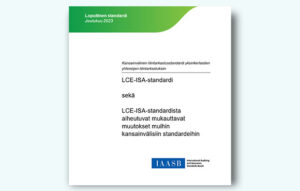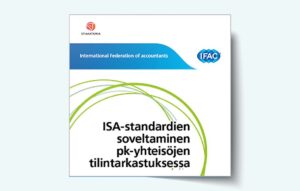ESG and Sustainability Reporting in Finland – CSRD: Responsibilities and opportunities for business leaders
E-book is published in 8/2024
89,00 €
(+ alv 14 %)
The subscription to the E-book is continuous, with a billing period of 12 months. See subscription terms.
Verkkokirjan tilaus on jatkuva, laskutuskausi 12 kk. Katso tilausehdot.
Implementing Sustainability Reporting Requirements for Businesses
Due to EU legislation, over a thousand Finnish companies will be required to report on their activities’ impacts on the environment, respect for human rights, and other social factors, as well as the economic effects these have on the company. This ESG (Environmental, Social, Governance) reporting requirement challenges companies across all management processes, questioning how to respond to the obligations and opportunities presented by the new legislation.
The book describes the new EU sustainable finance legislation and the legislative impacts of the Corporate Sustainability Reporting Directive (CSRD) on business operations, particularly from the perspectives of management and the board of directors. It offers practical methods for business leaders to analyse their company’s situation and establish robust procedures for the new sustainability reporting requirements. Additionally, it addresses the impacts of reporting requirements on major companies’ partners within their value chains.
The book covers the entire sustainability reporting process, from materiality analysis to data collection and interpretation, and from ESRS (European Sustainability Reporting Standards) requirements to practical reporting work and external assurance.
Combining legislation, researched data, and practical examples, this book is suitable not only for business leaders but also as a textbook for universities and for those pursuing the KRT certification.
Authors:
Dr. Hanna Silvola, Associate Professor (Hanken School of Economics): Dr. Silvola researches and teaches sustainability reporting and responsible investing at Hanken and in executive education programs. She also serves in various expert roles, including on the ESMA (European Securities and Markets Authority) advisory group on sustainable finance and in various ESG committees.
Elina Peill, LicSc (Econ.), Director (Deloitte): Peill contributes to the development of sustainability reporting practices as a member of the Administrative Board of EFRAG (European Financial Reporting Advisory Group), the body developing the ESRS standards. She also participates in Deloitte’s global working groups and advises companies and assurance teams.
Dr. Ingalill Aspholm, LL.M., Head of Regulatory Affairs & ESG Project Manager (Finnish Association of Auditors): Dr. Aspholm follows the regulation and assurance related to sustainability reporting from a strategic vantage point in Brussels, engaging with Accountancy Europe, the umbrella organization for the Finnish Association of Auditors.
Dr. Timo Kaisanlahti, Professor of Practice (Ministry of Economic Affairs and Employment / University of Helsinki): Dr. Kaisanlahti has been involved in the preparation of the sustainability reporting directive and has been responsible for the national legislative implementation of the directive.
1 Introduction
1.1 A book about sustainability – for whom?
1.2 Key terminology
2 Why is sustainability reporting necessary?
2.1 Current state of reporting and reasons for reporting
2.2 The EU sustainable finance programme and the role of sustainability reporting in the green transition
3 Legal basis and scope of sustainability reporting
3.1 Sustainability reporting as part of companies’ statutory disclosure obligations
3.2 National implementation of new sustainability reporting regulations in Finland
3.3 The sustainability report as a document and the scope of sustainability reporting
4 Duties and responsibilities of the Board of Directors and the auditor
4.1 Business principles and compliance
4.2 Is the auditor’s responsibility different in the audit of the sustainability report than in the audit of the accounts?
4.3 Can a Board member or auditor be criminally liable for the sustainability report?
5 How the scope of sustainability reporting is determined in practice
5.1 The ESRS standards and other guidelines
5.2 Key principles to be followed in reporting
5.3 Exemptions related to the start of reporting
5.4 What does reporting look like in practice?
5.5 Can material information be left unreported?
6 The materiality assessment and the role and involvement of stakeholders
6.1 The process of identifying material information in practice
6.2 Design of the materiality assessment and value chain analysis
6.3 Identifying material sustainability matters
6.4 Interaction with stakeholders
6.5 Assessment of materiality
6.6 Processing and reporting of results
6.7 Integration into other processes and strategy work
7 What information about (material) sustainability matters must be reported under the ESRS standards
7.1 How to identify disclosure requirements in the ESRS standards
7.2 General disclosure requirements
7.2.2 General disclosure requirements
7.2 Information to be provided by reporting area
7.4 ESRS E standards: Information about environmental impacts
7.5 ESRS S standards: Information about social impacts
7.6 ESRS G: Information about governance
7.7 Forthcoming reporting requirements
8 Sustainability reporting in practice
8.3 Step-by-step description of the process
8.4 Case: Metsä Group: A leader with the readiness to report as early as for the 2024 financial year
8.5 Case: Orthex: From voluntary reporting to statutory requirements in 2025
8.6 Work of the Audit Committee and ESG Committee in practice
8.7 Unlisted companies
9 Assurance of a sustainability report
9.1 Choosing a sustainability auditor
9.2 Audit Committee duties concerning the company’s sustainability reporting
9.3 Sustainability reports are assured in accordance with the approved Commission assurance standard
9.4 Which sustainability assurance standard should be used for assurance?
9.5 Auditors’ capacity to assure sustainability reports
9.6 From voluntary sustainability reporting to statutory sustainability reporting in specified form – how it works in practice for companies
9.7 Companies’ sustainability reporting in the future
10 Future outlook
10.2 Developments in sustainability reporting legislation in the coming years
10.3 Other upcoming EU legislative projects
10.4 The ultimate purpose of sustainability reporting
Authors
| E-book | Print book | |
|---|---|---|
| ISBN | ISBN 978-952-218-424-5 | not available |
| Library Classification | YKL 69.1 | |
| Pages | 288 |
The E-book will be available to you immediately after your subscription in the ST online services. If you are a new user, we will create a personal account for you, where you can access all your purchased products in the future.
Please review the subscription terms.
Kirjoittajat
 Hanna SilvolaKTT, Associate ProfessorHanken
Hanna SilvolaKTT, Associate ProfessorHanken Elina PeillKTL, FSA Credential Holder, DirectorDeloitte
Elina PeillKTL, FSA Credential Holder, DirectorDeloitte Ingalill AspholmKTT, johtava asiantuntijaSuomen Tilintarkastajat ry
Ingalill AspholmKTT, johtava asiantuntijaSuomen Tilintarkastajat ry Timo KaisanlahtiOTT, Professor of PracticeTyö- ja elinkeinoministeriö/Helsingin yliopisto
Timo KaisanlahtiOTT, Professor of PracticeTyö- ja elinkeinoministeriö/Helsingin yliopistoTutustu myös
Tutustu myös
-
Tilintarkastus | Kirja
Kansainvälinen tilintarkastusstandardi yksinkertaisten yhteisöjen tilintarkastuksiin (LCE-ISA-standardi)
79,00 € Valitse vaihtoehdoista Tällä tuotteella on useampi muunnelma. Voit tehdä valinnat tuotteen sivulla.Verkkokirja ilmestynyt 5/2024
Painettu kirja ilmestynyt 8/2024 -
Kestävä liiketoiminta | Kirja
ESG ja kestävyysraportointi – Yritysjohdon vastuu ja mahdollisuus
89,00 € Valitse vaihtoehdoista Tällä tuotteella on useampi muunnelma. Voit tehdä valinnat tuotteen sivulla.Verkkokirja päivitetty 3/2025
Painettu kirja ilmestynyt 4/2025 -
Tilintarkastus | Kirja
ISA-standardien soveltaminen pk-yhteisöjen tilintarkastuksessa
89,00 € (+ alv) Lisää ostoskoriinPäivitetty 2019
Kysyttävää? Autamme mielellämme!

Asiakaspalvelu
p. 09 7552 2010 (ark. klo 9–11 ja 13–15) Huom. Asiakaspalvelu on suljettuna 14.-25.7.
aspa@stakatemia.fi
Yhteydenottolomake
- ST-Akatemian asiakaspalvelu: julkaisut ja koulutukset
- Jäsenrekisterin tietojen muutokset






